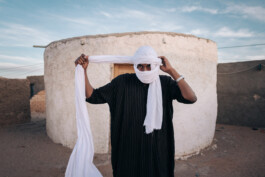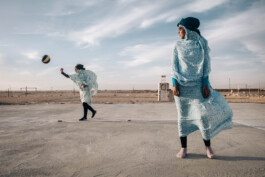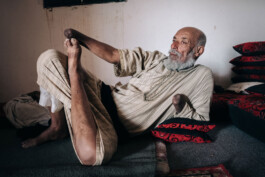










Western Sahara has been occupied by Morocco since it once was a Spanish colony until 1975. Spain left Western Sahara without finalizing the process of independence, as the UN had demanded. Instead, it allowed Moroccan military forces to invade the territory, in violation of international law and a decision from the International Court of Justice in The Hague. A 2500 kilometer long border wall covered with landmines separates more than 170 000 Sahrawis from their homes in Western Sahara. Still today, the Sahrawis live as a displaced people in Algerian refugee camps, almost forgotten by the wider public. The hopes of the older generation to one day be able to return to their homeland gradually vanishes. My aim with this project is to offer insight to the consequences of this conflict and the everyday lives of the Sahrawis living under occupation in one of the most inhospitable places on the planet.
is a half-Swiss, half-Norwegian photojournalist and sociologist. Since he completed his master’s degree in Sociology in 2017, he has been working as a freelance photographer, aiming to combine a sociological approach in his documentary work in order to contextualize and visualize neglected social issues.
matthiskleeb.com
@matthiskleeb
Con un approccio sensibile e umanista Matthis Kleeb ci racconta la quotidianità dei Sahrawis, popolo tra i più dimenticati dalla comunità internazionale, costretto all’esilio nei campi per rifugiati dell’Algeria a seguito di quella che sembra essere un’interminabile occupazione delle proprie terre da parte dell’esercito del Marocco. Le immagini di Kleeb malgrado l’armonia compositiva e la bellissima calda luce che cade sui volti dei ritrattati, ci trasmettono preoccupazione e sofferenza. Il fotografo ci mostra le conseguenze di questo conflitto, come i corpi lacerati dalle mine anti-uomo, ricordandoci che in questa parte di deserto nel Sahara occidentale esiste ancora un popolo che lotta giornalmente per il proprio riconoscimento.








Western Sahara has been occupied by Morocco since it once was a Spanish colony until 1975. Spain left Western Sahara without finalizing the process of independence, as the UN had demanded. Instead, it allowed Moroccan military forces to invade the territory, in violation of international law and a decision from the International Court of Justice in The Hague. A 2500 kilometer long border wall covered with landmines separates more than 170 000 Sahrawis from their homes in Western Sahara. Still today, the Sahrawis live as a displaced people in Algerian refugee camps, almost forgotten by the wider public. The hopes of the older generation to one day be able to return to their homeland gradually vanishes. My aim with this project is to offer insight to the consequences of this conflict and the everyday lives of the Sahrawis living under occupation in one of the most inhospitable places on the planet.
is a half-Swiss, half-Norwegian photojournalist and sociologist. Since he completed his master’s degree in Sociology in 2017, he has been working as a freelance photographer, aiming to combine a sociological approach in his documentary work in order to contextualize and visualize neglected social issues.
matthiskleeb.com
@matthiskleeb
Con un approccio sensibile e umanista Matthis Kleeb ci racconta la quotidianità dei Sahrawis, popolo tra i più dimenticati dalla comunità internazionale, costretto all’esilio nei campi per rifugiati dell’Algeria a seguito di quella che sembra essere un’interminabile occupazione delle proprie terre da parte dell’esercito del Marocco. Le immagini di Kleeb malgrado l’armonia compositiva e la bellissima calda luce che cade sui volti dei ritrattati, ci trasmettono preoccupazione e sofferenza. Il fotografo ci mostra le conseguenze di questo conflitto, come i corpi lacerati dalle mine anti-uomo, ricordandoci che in questa parte di deserto nel Sahara occidentale esiste ancora un popolo che lotta giornalmente per il proprio riconoscimento.